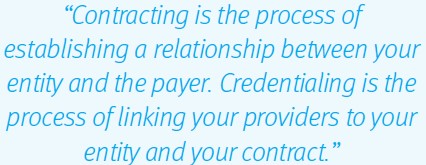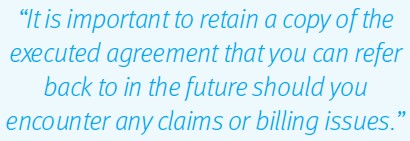Heather Rothermel
Consider this scenario: You’ve decided to open an urgent care center. You’ve secured funding, found the perfect location, hired amazing providers, created build-out plans to make it your own, and set a go-live date to open your doors to your community. Then you realize you haven’t started contracting and credentialing. In many markets, contracting and credentialing for a start-up can take 9 to 12 months or longer, and operators must consider this timeline in the early stages.
Contracting is the process of establishing a relationship between your entity and the payer.
Credentialing is the process of linking your providers to your entity and your contract.
These 2 pieces work together to ensure you receive reimbursement for services rendered at your clinic. It is imperative that you initiate these processes as soon as possible to ensure that you are ready to accept patients in your community as an in-network provider when you open your doors.
Contracting and Credentialing Process
The first step is to identify the payers that you would like to pursue in terms of contracting and credentialing. Your goal should be to identify the payers that represent as close to 100% of the members of your community as possible. There will likely be a blend of large national payers and smaller regional payers. If you are unsure of who to go after, look at your competitors or any large health systems in your area—this is a great benchmark to get started.
Once you have identified your list, you can reach out to the payers to initiate contracting. Most payers have a dedicated provider relations phone number and many have instructions on how to join their network on their websites.
In joining the network, you likely will be required to complete a demographic form or facility application. Be prepared with your physical address (including complete ZIP code plus 4 digit mail code), phone and fax number, tax identification number, type 2 group national provider identifier number, and hours of operation. You may also need to provide your billing address, billing phone and fax numbers, and a W-9.
After the payer receives your request, they will review it, and a contractor will reach out to you with additional instructions to proceed with contracting and credentialing. Payer credentialing requirements can vary depending on the type of agreement that you pursue; it is important to make sure you understand the requirements to add a provider to your agreement both in the initial contracting phase and after your agreement is effective.

When you receive the agreement from the payer, read the agreement carefully and understand the requirements of compliance or seek the assistance of professionals who can advise you. It will be important to understand the initial terms of the agreement and when you can request to modify the terms of reimbursement within your contract in the future.
Generally, the payers will offer you 1 of 2 reimbursement methodologies. Fee-for-service reimbursement is based on the plan’s established fee schedule. Each Current Procedural Terminology code will have an allowed amount, and, in this instance, you can anticipate being reimbursed for each service you offer. The other reimbursement type is a flat or global rate. Under this methodology, you can expect to be reimbursed 1 negotiated rate regardless of the acuity of care or the services that are provided. It will be important to consider your cost per visit to decide if you should try to negotiate the proposed reimbursement.
Finalize the Agreement
At the point that you are comfortable with the agreement and the reimbursement, you will want to finalize the agreement by submitted a signed copy to the payer for loading and execution. This process typically takes an additional 30 to 60 business days and begins when the payer receives the signed agreement from you. Though this process seems a bit like a black hole, the payer is actually setting up your entity and loading your fee schedule into their adjudication system with the goal of claims flying seamlessly through once you start seeing members.

When the plan has loaded your agreement, you should receive an executed agreement copy that is dually signed by your entity and the payer. It is important to retain a copy of the executed agreement that you can refer back to in the future should you encounter any claims or billing issues. At this point, you should also check the payer’s provider directory online to make sure you are listed as an in-network provider for all applicable product lines and that your information is listed correctly. The process of contracting and credentialing can be intimidating. Working with a knowledgeable advisory team that has established relationships at the payer level will help you navigate the contracting and credentialing processes. It is also likely that they will have market-level knowledge that can help you decide what payer agreements to pursue and what language or reimbursement is fair for your clinic.
Heather Rothermel is Contracting Operations Lead at Experity.
Read More
- Credentialing And Contracting: What To Expect When Expanding
- Contracting And Credentialing: A Complex Obstacle To Navigate
- Where Do You Start When Starting Your Urgent Care?
